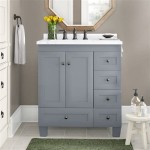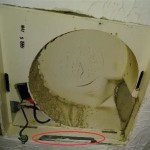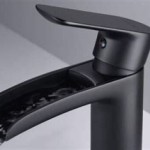Small Bathroom Vanity Basins: Optimizing Space and Style
The modern bathroom faces a significant challenge: maximizing functionality within limited square footage. Small bathrooms, particularly in apartments, condominiums, and older homes, necessitate creative solutions for storage and essential fixtures. The vanity basin, a crucial element in any bathroom, plays a pivotal role in balancing practicality and aesthetics. Selecting the appropriate vanity basin is paramount to optimizing space, ensuring usability, and enhancing the overall design of the small bathroom.
When considering small bathroom vanity basins, several factors come into play. These include the available space, the desired style, the plumbing configuration, and budget considerations. Ignoring these factors can lead to a cramped, inefficient, and visually unappealing bathroom. This article will explore the various types of small bathroom vanity basins, offering insights into their pros and cons and providing guidance on selection based on specific needs.
Understanding the Different Types of Small Bathroom Vanity Basins
The market offers a diverse range of small bathroom vanity basins, each designed to address specific space constraints and aesthetic preferences. Understanding the characteristics of each type is crucial for making an informed decision.
Wall-Mounted Basins: These basins are attached directly to the wall, freeing up floor space underneath. This creates a sense of spaciousness, making them ideal for very small bathrooms. Wall-mounted basins are available in various shapes and sizes, offering flexibility in design. However, they typically lack built-in storage, requiring separate storage solutions such as wall-mounted cabinets or shelves.
Installation of wall-mounted basins can be more complex compared to other types, as it requires secure wall mounting and proper plumbing connections. The wall’s structural integrity must be sufficient to support the weight of the basin, especially when filled with water. Furthermore, concealing the plumbing can be challenging, often necessitating creative solutions or professional installation.
Corner Basins: Designed to fit snugly into corners, these basins are an excellent option for bathrooms with awkward layouts or limited wall space. Corner basins maximize otherwise unused space, providing a functional washing area without encroaching significantly on the room's footprint. Like wall-mounted basins, they typically lack integrated storage, necessitating alternative storage solutions.
The shape of corner basins can vary, ranging from triangular to rounded designs. The choice depends on the available corner space and the overall aesthetic of the bathroom. Installation is relatively straightforward, requiring secure mounting to the corner walls and proper plumbing connections.
Pedestal Basins: Pedestal basins consist of a basin supported by a freestanding pedestal. While they occupy floor space, their sleek design and relatively small footprint make them suitable for small bathrooms. Pedestal basins offer a classic and elegant look, often preferred in traditional bathroom designs. However, similar to wall-mounted and corner basins, they lack integrated storage.
The pedestal serves to conceal the plumbing, providing a clean and finished appearance. Pedestal basins are relatively easy to install, requiring secure mounting to the floor and proper plumbing connections. The pedestal itself is typically made of ceramic or porcelain, matching the basin material.
Semi-Pedestal Basins: These basins combine the advantages of wall-mounted and pedestal basins. The basin is mounted to the wall, with a short pedestal extending to the floor. This provides a partially concealed plumbing solution while freeing up some floor space compared to full pedestal basins. Semi-pedestal basins offer a modern and minimalist aesthetic.
Installation of semi-pedestal basins requires careful planning to ensure proper alignment and secure mounting to both the wall and the floor. The pedestal provides additional support and helps to conceal the plumbing, contributing to a cleaner look.
Vanity Units with Integrated Basins: Vanity units combine a basin with a cabinet or drawer unit, providing valuable storage space in addition to a washing area. These units are particularly beneficial in small bathrooms where storage is at a premium. Vanity units are available in various sizes, styles, and finishes, offering a wide range of options to suit different bathroom designs.
The integrated basin is typically made of ceramic, porcelain, or composite materials, seamlessly blending with the cabinet or drawer unit. Installation requires connecting the plumbing to the basin and securing the unit to the wall or floor. Careful consideration should be given to the dimensions of the vanity unit to ensure it fits comfortably within the available space.
Countertop Basins: These basins sit on top of a countertop, creating a stylish and modern look. Countertop basins can be paired with various countertop materials, such as wood, stone, or laminate, allowing for customization and design flexibility. While they require a countertop surface, the space beneath can be utilized for storage.
Countertop basins are available in various shapes and sizes, ranging from round to rectangular to oval designs. Installation involves cutting a hole in the countertop for the drain and connecting the plumbing. The height of the countertop should be carefully considered to ensure comfortable use of the basin.
Factors to Consider When Choosing a Small Bathroom Vanity Basin
Selecting the right small bathroom vanity basin involves careful consideration of several factors. These factors determine the basin's suitability for the specific bathroom space and the user's needs.
Space Constraints: The most critical factor is the available space in the bathroom. Measure the area where the basin will be installed, taking into account any obstructions such as doors, windows, or other fixtures. Choose a basin that fits comfortably within the available space without making the bathroom feel cramped. Consider the depth of the basin, as a shallower basin may be preferable in very small bathrooms.
Storage Needs: Evaluate your storage requirements. If storage space is limited, opt for a vanity unit with integrated storage. If storage is not a primary concern, a wall-mounted, corner, or pedestal basin may be suitable. Consider adding wall-mounted cabinets or shelves to supplement storage if necessary.
Style and Aesthetics: The basin should complement the overall style and aesthetics of the bathroom. Choose a basin with a design that matches the existing fixtures and décor. Consider the shape, color, and material of the basin to ensure it integrates seamlessly into the bathroom's design scheme.
Plumbing Configuration: Assess the existing plumbing configuration. The location of the water supply and drain lines will influence the type of basin that can be installed. Consider whether the plumbing needs to be concealed or if it can be exposed. If necessary, consult with a plumber to determine the best plumbing solution for the chosen basin.
Budget: Set a budget for the basin and installation. Prices vary depending on the type, size, material, and brand. Research different options and compare prices to find a basin that fits within your budget. Remember to factor in the cost of installation, as this can be a significant expense.
Material and Durability: Choose a basin made of durable and easy-to-clean materials. Common materials include ceramic, porcelain, stone, and composite materials. Consider the maintenance requirements of each material before making a decision. Ceramic and porcelain are generally easy to clean and maintain, while stone may require more specialized cleaning products.
Height and Accessibility: Consider the height of the basin and its accessibility for all users. The basin should be at a comfortable height for washing hands and face. If the bathroom is used by individuals with mobility issues, ensure the basin is accessible and meets accessibility guidelines.
Installation Considerations for Small Bathroom Vanity Basins
Proper installation is crucial for the functionality and longevity of the small bathroom vanity basin. Whether you are a DIY enthusiast or prefer professional installation, understanding the process is essential.
Preparation: Before beginning the installation, gather all the necessary tools and materials. These may include a wrench, screwdriver, drill, level, measuring tape, sealant, and plumbing fittings. Turn off the water supply to the bathroom to prevent leaks during installation. Protect the surrounding surfaces with drop cloths or plastic sheeting.
Wall Mounting: For wall-mounted basins, ensure the wall is structurally sound and can support the weight of the basin. Use appropriate wall anchors and screws to secure the basin to the wall. Use a level to ensure the basin is installed straight and level. Connect the water supply and drain lines, using sealant to prevent leaks.
Corner Mounting: For corner basins, ensure the corner walls are square and structurally sound. Use appropriate wall anchors and screws to secure the basin to the corner walls. Use a level to ensure the basin is installed straight and level. Connect the water supply and drain lines, using sealant to prevent leaks.
Pedestal Mounting: For pedestal basins, secure the pedestal to the floor using appropriate screws or adhesive. Carefully place the basin on top of the pedestal, ensuring it is properly aligned. Connect the water supply and drain lines, using sealant to prevent leaks.
Vanity Unit Mounting: For vanity units, secure the unit to the wall or floor according to the manufacturer's instructions. Connect the water supply and drain lines to the integrated basin, using sealant to prevent leaks. Ensure the unit is level and stable before use.
Countertop Basin Mounting: For countertop basins, cut a hole in the countertop for the drain, following the manufacturer's specifications. Place the basin on top of the countertop, ensuring it is properly aligned. Connect the water supply and drain lines, using sealant to prevent leaks. Secure the countertop to the vanity unit or support structure.
Plumbing Connections: Ensure all plumbing connections are tight and leak-free. Use Teflon tape or pipe dope on threaded connections to prevent leaks. Check for leaks after turning on the water supply. Tighten any loose connections as needed.
Sealing: Apply sealant around the edges of the basin where it meets the wall or countertop to prevent water damage. Use a high-quality sealant that is resistant to mold and mildew. Smooth the sealant with a wet finger or tool for a clean and professional finish.
Testing: After installation, thoroughly test the basin to ensure it is functioning properly. Check for leaks, proper drainage, and stable mounting. Make any necessary adjustments or repairs before using the basin.
Selecting and installing a small bathroom vanity basin requires careful planning and consideration. By understanding the different types of basins, the factors to consider when choosing a basin, and the installation process, individuals can optimize space and style in their small bathrooms, creating a functional and aesthetically pleasing environment.

Pvc Vanity Cabinets Bathroom Wash Basin With Modern D Small Vanities Washbasin Design Cabinet

Pvc Vanity Cabinets Bathroom Wash Basin With Washbasin Design Small Vanities Remodel Diy

Solid Oak Bathroom Cabinet Compact Vanity Sink Small Units

10 Vanity Units Perfect For Small Bathrooms Victorian Plumbing

Bathroom Wash Basin Vanity Unit With Cabinet For Storage By Miza Lorange Com

Bathroom Vanity Collection Of Large And Small Units

Popular Bathroom Vanity Designs Types Beautiful Homes

Buy Classic Bathroom Vanity Designs Single Sink Fuao

Wash Basin Vanity Designs For Your Home Designcafe

Small Space Bathroom Vanity Units For Ideal Centre
Related Posts







